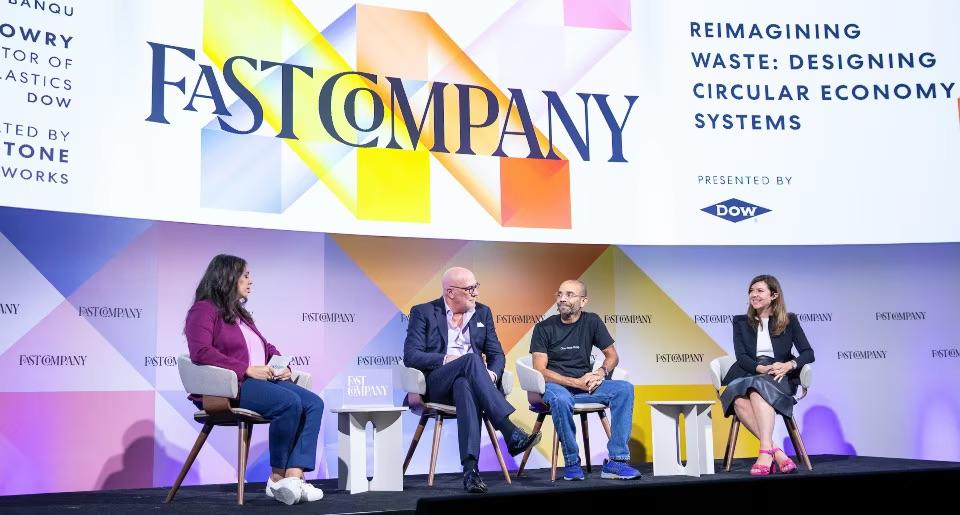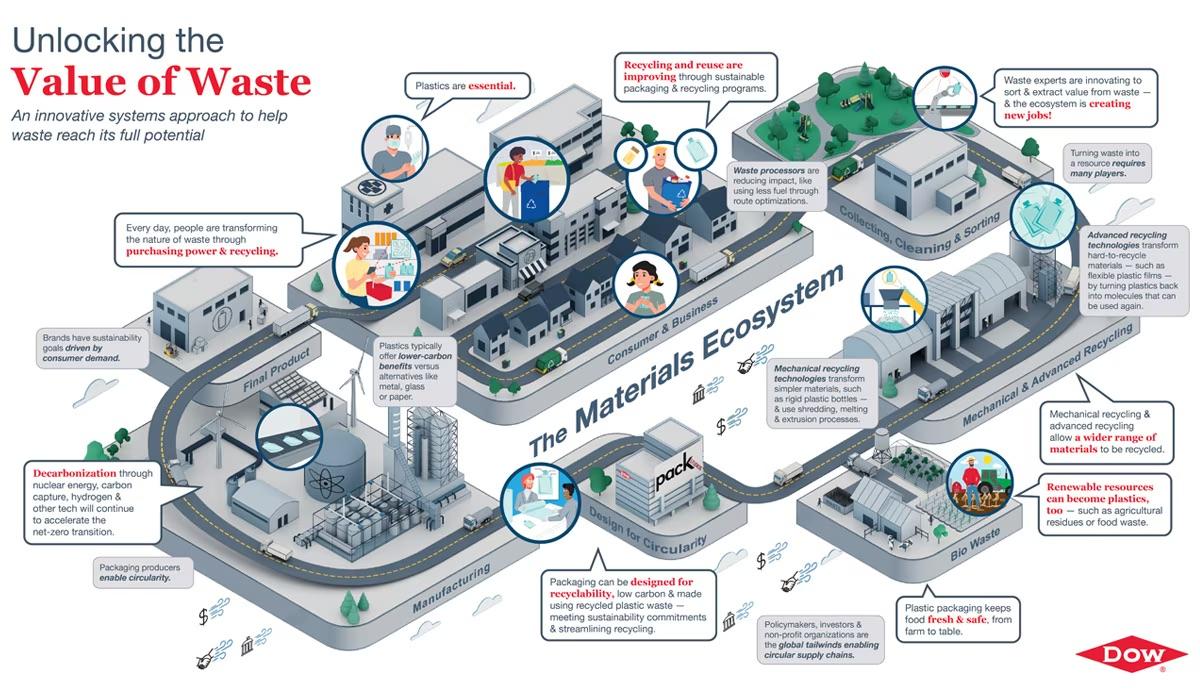The Materials Ecosystem: Unlocking the Value of Waste
By sharing our perspective on the dynamics of the materials ecosystem – its connections, influencers and gaps, we aim to inspire, highlight the work of others and invite conversation.
Here’s a riddle: what does a global materials science company such as Dow have in common with farmers in Iowa, investors in Southeast Asia and waste pickers in for example Kenya or Brazil? We are all part of the diverse and complex materials ecosystem that is developing around plastic and renewable waste to deliver its total value.
Why is this happening? The world is demanding a better way to make, use and reuse plastics. Too much plastic enters our natural environment, and that’s unacceptable. It’s also unacceptable to view this valuable material as waste in the first place. The Ellen MacArthur Foundation estimates that by 2040, a circular economy has the potential to reduce the annual volume of plastics entering our oceans by 80%; reduce greenhouse gas emissions by 25%; generate savings of $200 billion per year; and create 700,000 net additional jobs. Recycling just 20% of all single-use plastic could generate more than $10 billion in economic activity.
The opportunity is huge, but so is the complexity needed to scale change – and that is where a systems approach comes in. As the world transforms to a circular economy, we are being challenged to not only think about waste as a resource but also to change business models, logistics, consumption behaviors, policy and infrastructure. Experts in systems thinking believe the first step to solving a complex challenge like waste is to understand the system in which it sits. Meaningful change only happens when we understand the web of interrelations and rethink assumptions.
That is why we are employing a systems lens to identify the gaps, connect the best partners and give it our best to scale how the world values, sources, transforms and monetizes plastic waste.
In this first of a series of Seek Together blog articles to highlight our new insights on the materials ecosystem, let’s take a look at how we’re defining that system and our role in it.
What is the materials ecosystems?
When I think of circularity for plastics, I often think of how connected gears work together to make something larger work. As you can see in the illustration below, the materials ecosystem includes everyday consumers like you and me – and stakeholders in waste management, recycling, design, manufacturing, retail, brand ownership and public policy. It is a web of interrelated technologies, processes and people that transform used plastic and renewables into useful materials.
It takes every stakeholder working together to make change happen. This includes brand owners and manufacturers designing products to be recyclable, effective recycling and waste infrastructure systems to recover end-of-life plastics, and investments across the value chain in new technologies that will transform recycled and renewable materials into products that create value. It also takes policymakers, investors and consumers to enable a systemic shift.
In addition, it takes an appreciation of the nuances of local waste systems. While plastic waste is a global problem, solutions are highly localized. An improved understanding of local ecosystem actors and existing waste management systems can help ensure initiatives and investments to scale-up plastics recycling achieve the greatest impact and are tailored to the unique needs and strengths of communities.
It’s a complex system, for sure. But by understanding the complexity, I believe we can strengthen the role we play and who we work with.
Putting systems thinking into action
What does applying a system lens look like in our work?
For us, it starts with first understanding local systems around plastic waste – and then collaborating with the best partners and technologies for the collection, reuse and recycling of waste to enable global material ecosystems to scale.
Together, we look at how things can connect better. We try to understand what influences consumer behaviors. We also consider how policy is a driving force in many ways – and we examine the gaps in the ecosystem and how we can address them.
Take our work with Delterra, for example, in Argentina – where recycling rates hover at 8%. We work with Delterra to promote a circular economy and increase recycling rates through the Rethinking Recycling Program. By involving government, local recycling cooperatives, waste generators, consumers and private companies the independent environmental nonprofit seeks to improve waste management systems.
This is one recent example of how the public’s good intentions and recycling capacity connect and how global organizations are improving recycling as a key part of materials-management efforts.
Learning by listening
Albert Einstein is often quoted as saying, “We cannot solve our problems with the same level of thinking that created them.” I am continually inspired by our collaborators, and the bold moves they are making with us to disrupt and create a new plastics economy.
Recently, I shared a stage at Fast Company’s Innovation Festival with two entrepreneurs who represented vastly different roles in the materials ecosystem: Thomas Corle, CEO of New Energy Blue, and Ashish Gadnis, CEO of BanQu. Corle founded a bio-conversion company that uses renewables such as corn leaves and stems, and Gadnis runs a blockchain supply chain and economic identity platform for disenfranchised workers.
Dow and New Energy Blue announced a long-term supply agreement in North America in which New Energy Blue will create bio-based ethylene from crop residues for plastics production. Recently, Dow and BanQu began work together in a pilot project called "2Life." Using blockchain technology, the 2Life Project aims to advance the development of the value chain traceability of our REVOLOOP™ post-consumer recycled resin manufactured in Colombia.
These entrepreneurs share some important traits. They don’t see waste as waste. They focus on people – farmers and waste pickers. They are diversifying how we source materials for plastics – both by what materials we use and by valuing the diverse people connected to those materials. Importantly, they are innovators with a vision of how they can do their part to advance a future that is more circular and lower carbon.
These disruptors demonstrate that by working together across the materials ecosystem, we can indeed make the whole greater than the sum of the parts and turn complex challenges into opportunities for sustainability.
Check out our insights on the materials ecosystem
By sharing our perspective on the dynamics of the materials ecosystem – its connections, influencers and gaps, we aim to inspire, highlight the work of others and invite conversation.
I welcome you to check it out at Dow.com/materialsecosystem.
Haley Lowry, Director of Sustainability at Dow



